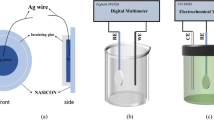Abstract
The objective of this study was to develop a pH sensor for monitoring hydrogen ion activity in situ in oilfield-produced water under subsurface conditions. An iridium oxide film was prepared, and the performance of the iridium oxide film was evaluated in produced water using a series of high salinities, temperatures, and pressures. Scanning electron microscopy (SEM), energy-dispersive X-ray spectroscopy (EDS), and X-ray photoelectron spectroscopy (XPS) were employed to assess the morphology and oxidation state of the iridium oxide film. A series of open-circuit potential (OCP) measurements were performed to access the sensitivity and stability of the iridium oxide film electrode in produced water. Research results indicated that the pH sensor exhibits a very high sensitivity in the environment with varied interference ions, including Na+, Mg2+, Ca2+, Cl−, and SO4 2−, and the existence of sodium chloride in produced water made a slight positive shift of potential. The iridium oxide film-based pH sensor exhibited a near-Nernstian response at −57.9 mV/pH in produced water. An increase in temperature from 24 to 80 °C decreased the pH potential. Compared with the theoretical Nernst equation, the iridium oxide sensor showed fair Nernstian behavior at high temperatures. The iridium oxide pH sensor was accurately investigated under high pressure; the sensor seems independent of pressure, and the slope is the same at different potentials under a wide range of pressures.






Similar content being viewed by others
References
Schlumberger (2008) Quantitative fluid measurements at reservoir conditions, in real time. http://www.slb.com/insitu.aspx
Min SK, Samaranayake CP, Sastry SK (2011) In situ measurement of reaction volume and calculation of pH of weak acid buffer solutions under high pressure. J Phys Chem B 115(20):6564–6571. doi:10.1021/jp1110295
Kitamura Y, Itoh T (1987) Reaction volume of protonic ionization for buffering agents. Prediction of pressure dependence of pH and pOH. J Solut Chem 16(9):11. doi:10.1007/bf00652574
Xian C, Raghuraman B, Carnegie AJ, Goiran P-O, Berrim A (2008) Downhole pH as a novel measurement tool in carbonate formation evaluation and reservoir monitoring. Petrophysics 49(2): 159-171.
Steegstra P, Ahlberg E (2012) Influence of oxidation state on the pH dependence of hydrous iridium oxide films. Electrochim Acta 76:26–33. doi:10.1016/j.electacta.2012.04.143
Zhang RH, Zhang XT, Hu SM (2008) Zr/ZrO2 Sensors for in situ measurement of pH in high-temperature and -pressure aqueous solutions. Anal Chem 80(8):2982–2987. doi:10.1021/ac070684u
Kriksunov LB, Macdonald DD, Millett PJ (1994) Tungsten/tungsten oxide pH sensing electrode for high temperature aqueous environments. J Electrochem Soc 141(11):3002–3005. doi:10.1149/1.2059272
Katsube T, Lauks I, Zemel JN (1981) pH-sensitive sputtered iridium oxide films. Sensors Actuators 2:399–410. doi:10.1016/0250-6874(81)80060-1
Lauks I, Yuen MF, Dietz T (1983) Electrically free-standing IrOitx thin film electrodes for high temprature, corrosive environment pH sensing. Sensors Actuators 4:375–379. doi:10.1016/0250-6874(83)85047-1
Dobson JV, Snodin PR, Thirsk HR (1976) EMF measurements of cells employing metal-metal oxide electrodes in aqueous chloride and sulphate electrolytes at temperatures between 25–250 °C. Electrochim Acta 21(7):527–533. doi:10.1016/0013-4686(76)85143-2
Kreider K (1991) Iridium oxide thin-film stability in high-temperature corrosive solutions. Sensors Actuators B Chem 5(1–4):165–169. doi:10.1016/0925-4005(91)80239-G
Yao S, Wang M, Madou M (2001) A pH electrode based on melt-oxidized iridium oxide. J Electrochem Soc 148(4):H29–H36. doi:10.1149/1.1353582
Glab S, Hulanicki A, Edwall G, Ingman F (1989) Metal-metal oxide and metal-oxide electrodes as pH sensor. Crit Rev Anal Chem 21(1):29–47. doi:10.1080/10408348908048815
Huang W-D, Cao H, Deb S, Chiao M, Chiao JC (2011) A flexible pH sensor based on the iridium oxide sensing film. Sensors Actuators A Phys 169(1):1–11. doi:10.1016/j.sna.2011.05.016
Neff J, Lee K, DeBlois E (2011) Produced water: overview of composition, fates, and effects. In: Lee K, Neff J (eds) Produced water. Springer, New York, pp 3–54. doi:10.1007/978-1-4614-0046-2_1
Teruaki Katsube IRL, van der Spiegel J, Zemel JN (1983) High temperature and high pressure pH sensors with sputtered iridium oxide films. Jpn J Appl Phys 22:4
Yiwen Pan WESJ (2008) Experimental and theoretical constraints on pH measurements with an iridium oxide electrode in aqueous fluids from 25 to 175 °C and 25 MPa. J Solut Chem 37:12
Sanjines R, Aruchamy A, Levy F (1989) Thermal stability of sputtered iridium oxide films. J Electrochem Soc 136(6):4
Chalamala BR, Yi W, Reuss RH, Aggarwal S, Gnade BE, Ramesh R, Bernhard JM, Sosa ED, Golden DE (1999) Effect of growth conditions on surface morphology and photoelectric work function characteristics of iridium oxide thin films. Appl Phys Lett 74(10):1394–1396. doi:10.1063/1.123561
Acknowledgments
We gratefully acknowledge the support of the Department of Energy through the National Energy Technology Laboratory under contract number DE-FE0009878. The authors appreciate the aid of Liz Bustamante for her assistance in editing this manuscript.
Author information
Authors and Affiliations
Corresponding authors
Electronic supplementary material
Below is the link to the electronic supplementary material.
ESM 1
(DOC 239 kb)
Rights and permissions
About this article
Cite this article
Yu, J., Khalil, M., Liu, N. et al. Iridium oxide-based chemical sensor for in situ pH measurement of oilfield-produced water under subsurface conditions. Ionics 21, 855–861 (2015). https://doi.org/10.1007/s11581-014-1214-0
Received:
Revised:
Accepted:
Published:
Issue Date:
DOI: https://doi.org/10.1007/s11581-014-1214-0




